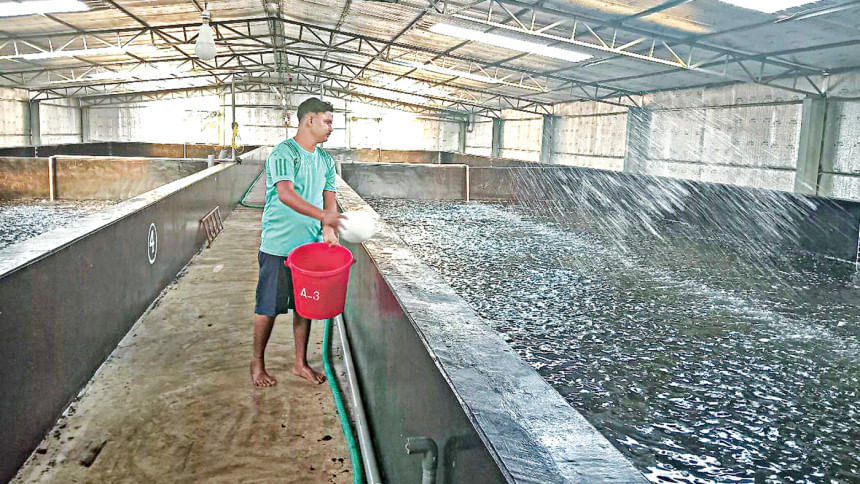Debt, disease and weak fry cripple export-oriented shrimp sector

Once Bangladesh's second-largest export earner, the shrimp industry now teeters on the brink. The industry was considered the cornerstone of the coastal economy, sustaining millions of livelihoods. But disease, poor fry quality, illegal imports, and climate extremes have thrown the sector into crisis, threatening both farmers and hatchery owners alike.Take the example of Jagadish Roy of Foria village in Khulna's Paikgachha upazila, who has spent more than 20 years farming bagda, or black tiger,...
Once Bangladesh's second-largest export earner, the shrimp industry now teeters on the brink. The industry was considered the cornerstone of the coastal economy, sustaining millions of livelihoods. But disease, poor fry quality, illegal imports, and climate extremes have thrown the sector into crisis, threatening both farmers and hatchery owners alike.
Take the example of Jagadish Roy of Foria village in Khulna's Paikgachha upazila, who has spent more than 20 years farming bagda, or black tiger, shrimp. Yet, he says, he has never felt secure in this business.
"The fry we buy from local hatcheries are cheaper but of poor quality," he said. "They survive for at best 60 days, but a shrimp needs around 100 days to reach full size. We also face severe shortages of fry when the deep-sea fishing ban is imposed, as no mother shrimp can be collected during that time."
Poor-quality fry often carry disease, he added, and many farmers resort to illegally imported shrimp from India to fill the gaps. But these, too, frequently die prematurely, destroying entire ponds and leaving farmers in staggering debt.
"About 90 percent of shrimp farmers in our area are in debt," Roy said. "The land here isn't suitable for anything other than shrimp farming, so we can't leave it. When one farmer goes bankrupt, another takes over, but everyone remains burdened with loans."
Virus attacks, he explained, often strike when shrimp shed their shells at 30-35 days, wiping out months of labour and investment in a single blow.
Jagadish's struggle is echoed across the southwest coast. Shrimp fry produced in Cox's Bazar supply the farms of Khulna, Satkhira, and Bagerhat. Coastal salinity makes the district ideal for hatcheries, yet the sector there is shrinking. Where once about 60 hatcheries operated, only 25-30 remain.
"If I quit now, I'd be left with around Tk 5 crore in debt," said Zakir Ullah, managing director of a Cox's Bazar hatchery. "We sell 1,000 shrimp fry for Tk 250 on average, but our production cost is around Tk 300. We continue only to avoid bankruptcy."
Many of the original hatchery owners have left the business, leaving it to renters. Harunur Rashid, managing director of Belie Hatchery in Kolatoli, said the exit of experienced operators has coincided with falling demand. "Many farmers, overwhelmed by debt, have quit farming," he said. "Exports have also dropped, pushing prices down further."
The deep-sea fishing ban, spanning June and July, compounds these challenges. During this period, no vessels can collect mother shrimp, halting the production of local fry.
Salehin Rahman Mohian, executive member of the Shrimp Hatchery Association of Bangladesh and director of Niribili Hatchery, explained that hatchery owners often sit idle during the peak season. "Some hatcheries import larvae from Indian nurseries," he added. "These illegal imports are often of poor quality and cause heavy losses for farmers."
SM Babor, office secretary of the Shrimp Hatchery Association of Bangladesh, said Cox's Bazar produces around 700-800 crore shrimp fry annually. "At one point, there were 58 hatcheries here. Now only 25-30 remain," he said, noting that 25-30 new hatcheries have emerged in Satkhira, using seawater transported by trawlers.
The management of hatcheries is further complicated by weak broodstock practices and occasional fraud.
Cox's Bazar District Fisheries Officer Nazmul Huda described the situation as "very complex." Pond water temperatures on the southwest coast rise to 37°C-44°C from April to June, creating conditions unsuitable for shrimp. Silt accumulation reduces pond depth, while disease outbreaks are frequent. "Some hatcheries import fake nauplii, nurse them, and sell them as local fry."
During the fishing ban, fisheries officials monitor hatcheries in Cox's Bazar and Satkhira to prevent the illegal nursing of post-larvae. "If any hatchery is found with post-larvae brought in illegally, we destroy them immediately," Huda said.
Despite this, complaints persist about secret nursing, as some traders attempt to meet the high demand for fry during the ban period.
Across the coastal districts, about 30 lakh people are directly involved in shrimp farming, hatcheries, and processing, with another 20 lakh indirectly dependent on the sector. Yet production has fallen sharply over the past decade.
Between 2010 and 2014, Bangladesh produced 120,000 to 133,000 tonnes of bagda shrimp; by 2020, this had dropped to 42,000 tonnes. Shrimp exports, which peaked at $550 million in FY2014, fell sharply before a modest recovery of 19 percent in FY2024-25 to $296 million.
In July 2025, exports rose 47 percent year-on-year to $31 million, but industry insiders note that this reflects stronger prices and a higher US dollar, rather than a meaningful increase in output.
Industry insiders emphasize that the challenges are structural as much as financial. "Due to repeated policy mistakes, the shrimp industry is collapsing," Mohian said.
He added, "Bangladesh lost global market share in vannamei shrimp because of delays in policy approval. Now European buyers are showing renewed interest in bagda shrimp for its taste, so the government should step in to ensure quality fry, medicine, and feed to boost production and export earnings."